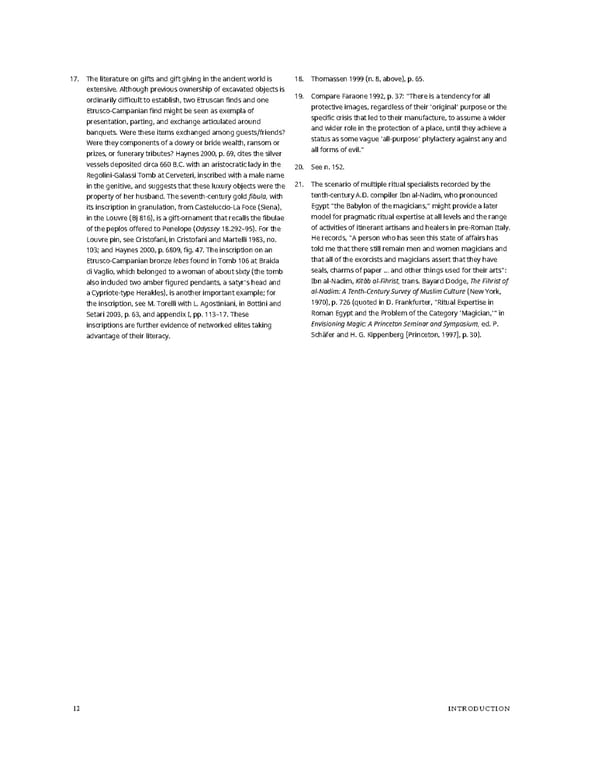17. The literature on gifts and gift giving in the ancient world is 18. Thomassen 1999 (n. 8, above), p. 65. extensive. Although previous ownership of excavated objects is 19. CompareFaraone 1992, p. 37: “There is a tendency for all ordinarily difficult to establish, two Etruscan finds and one protective images, regardless of their ‘original’ purpose or the Etrusco-Campanian find might be seen as exempla of specific crisis that led to their manufacture, to assume a wider presentation, parting, and exchange articulated around and wider role in the protection of a place, until they achieve a banquets. Were these items exchanged among guests/friends? status as some vague ‘all-purpose’ phylactery against any and Were they components of a dowry or bride wealth, ransom or all forms of evil.” prizes, or funerary tributes? Haynes 2000, p. 69, cites the silver vessels deposited circa 660 B.C. with an aristocratic lady in the 20. Seen. 152. Regolini-Galassi Tomb at Cerveteri, inscribed with a male name in the genitive, and suggests that these luxury objects were the 21. The scenario of multiple ritual specialists recorded by the property of her husband. The seventh-century gold fibula, with tenth-century A.D. compiler Ibn al-Nadim, who pronounced its inscription in granulation, from Casteluccio-La Foce (Siena), Egypt “the Babylon of the magicians,” might provide a later in the Louvre (Bj 816), is a gift-ornament that recalls the fibulae model for pragmatic ritual expertise at all levels and the range of the peplos offered to Penelope (Odyssey 18.292–95). For the of activities of itinerant artisans and healers in pre-Roman Italy. Louvre pin, see Cristofani, in Cristofani and Martelli 1983, no. He records, “A person who has seen this state of affairs has 103; and Haynes 2000, p. 6809, fig. 47. The inscription on an told me that there still remain men and women magicians and Etrusco-Campanian bronzelebesfound in Tomb 106 at Braida that all of the exorcists and magicians assert that they have di Vaglio, which belonged to a woman of about sixty (the tomb seals, charms of paper … and other things used for their arts”: also included two amber figured pendants, a satyr’s head and Ibn al-Nadim, Kitāb al-Fihrist, trans. Bayard Dodge, The Fihrist of a Cypriote-type Herakles), is another important example; for al-Nadim: A Tenth-Century Survey of Muslim Culture (New York, the inscription, see M. Torelli with L. Agostiniani, in Bottini and 1970), p. 726 (quoted in D. Frankfurter, “Ritual Expertise in Setari 2003, p. 63, and appendix I, pp. 113–17. These Roman Egypt and the Problem of the Category ‘Magician,’” in inscriptions are further evidence of networked elites taking Envisioning Magic: A Princeton Seminar and Symposium, ed. P. advantage of their literacy. Schäfer and H. G. Kippenberg [Princeton, 1997], p. 30). 12 INTRODUCTION
 Ancient Carved Ambers in the J. Paul Getty Museum Page 21 Page 23
Ancient Carved Ambers in the J. Paul Getty Museum Page 21 Page 23